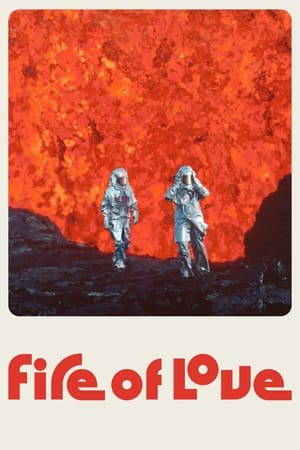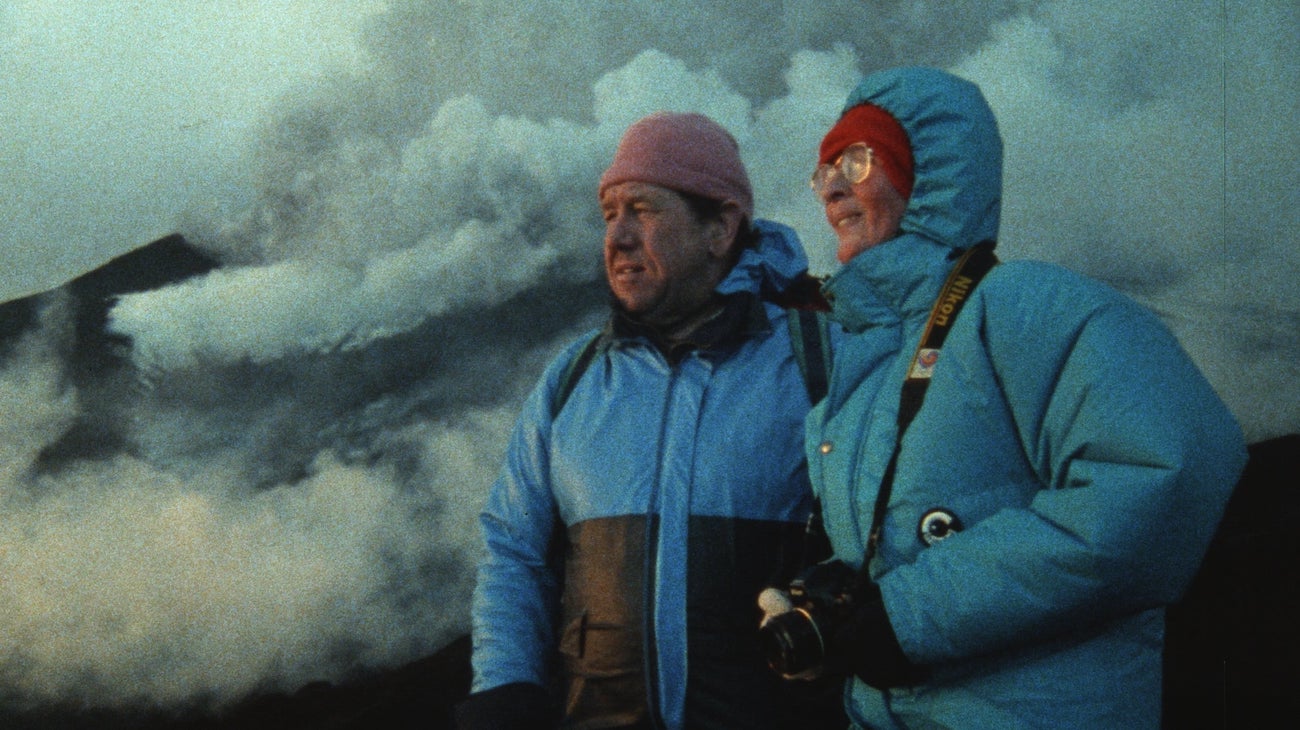
Proximity serves as both fascination and frustration in Fire of Love, a documentary portrait of the Alsatian French volcanologists Katia and Maurice Krafft. Let’s begin with physical proximity, since it was the couple’s penchant for cozying up to active volcanoes that captured the world’s imagination and—this isn’t remotely a spoiler; the movie informs us of it right up front—ultimately resulted in their death, when they and several dozen others were unexpectedly engulfed by a pyroclastic flow (imagine hot lava, but in gaseous form that can travel at more than 400 miles per hour) emanating from the eruption of Japan’s Mount Unzen in June of 1991. The Kraffts always knew that this might be their fate, and were remarkably sanguine about it, in the way that mountain climbers and other driven daredevils tend to be. The danger was much of the allure, though they were also in thrall to the sheer beauty of volcanic activity, which they documented in decades’ worth of films and photographs. Fire of Love serves, among other things, as a greatest-hits collection from their archive, reveling in the otherworldly burbling of our planet’s molten underbelly; it’s one thing to see aerial footage taken from a safe distance, and quite another to watch two cheerful dorks in flimsy-looking protective gear stand yards away from plumes of fiery-red material belched from the Earth’s furnace.
We’ve seen documentaries of this sort before, of course. Early in his career, Werner Herzog attempted to capture an impending eruption, though La Soufrière (1977), the resulting half-hour short, in fact only explores the eerie silence of an evacuated region, as the volcano in question never blew. Decades later, Herzog returned to the subject with Into the Inferno, a meditation on all things volcanic that features some of the Kraffts’ footage and gives an abbreviated account of their story. (There’s also Lessons of Darkness, shot in Kuwait’s oil fields immediately after the Gulf War, which obviously isn’t about volcanoes at all but frequently looks just as gorgeously hellish.) What theoretically distinguishes Fire of Love, as its title suggests, is the film’s exploration of Katia and Maurice’s relationship. The two of them are pretty darn irresistible, albeit more so individually than as a unit. Katia, small and birdlike, radiates a chipper enthusiasm that suggests someone talking about cute, cuddly animals rather than death-spewing ruptures. Maurice has the genial, rumpled air one associates with tenured professors, but with an endearingly goofy streak; fans of classic French cinema may be reminded of Michel Simon (from L’Atalante and Boudu Saved From Drowning, among many others). Their shared passion fueled their marriage, and while it’s of course very sad that they died young (both were under 50), there’s something terribly romantic about doing so together while pursuing their mutual lifelong dream.
However, it’s here that proximity, or the lack thereof, becomes a bit of a liability. While the Kraffts shot an enormous amount of volcano-related footage, and frequently appear on-camera near volcanoes, they apparently weren’t the sort of people who felt compelled to document their everyday lives. To be fair, that was true of virtually everyone until quite recently—carrying a pocket-sized device that can capture moving images dates back only to about 2009, and even ‘80s camcorders, while less burdensome than 8mm film, were a giant pain in the ass. (While the Kraffts owned professional-grade equipment, celluloid was expensive; they wouldn’t likely have burned money shooting themselves in casual repose.) Consequently, director Sara Dosa was forced to construct Katia and Maurice’s life together from their numerous media appearances, which are often delightful but never what you’d call candid or unguarded. We get occasional tantalizing hints of discord, as when Maurice decides to row a specially designed boat onto what’s basically a lake of acid in Java, just for the adrenaline rush and bragging rights; Katia, who’s no coward but also no dummy, refuses to accompany him (as does everyone on their team with the slightest background in chemistry), but if his insistence on this reckless endeavor, which he miraculously survived, created any fracture lines in their marriage, Fire of Love doesn’t know about it. The film shows us only what they self-consciously presented to the world.
To her credit, Dosa clearly recognizes the problem, and comes up with an effective partial solution. Rather than merely depict its central relationship, the film actively mythologizes it, treating Katia and Maurice as if they were Cleopatra and Antony—legendary figures from long ago, whose exploits have been passed down over generations. This effect is achieved via voiceover narration that’s singular in a couple of important respects. First, the words themselves (for which no fewer than four writers, including Dosa, get onscreen credit) are considerably more poetic than docs generally get; because I saw Fire of Love in a theater, I can’t quote any of it for you, alas, but a great deal of care went into crafting every sentence, to the point where it almost feels, in the best possible way, as if the film were an adaptation of somebody’s first-rate third-person memoir. Even more crucially, Dosa entrusted the job of reading this narration to Miranda July (writer-director-star of such indies as The Future and Me and You and Everyone We Know), whose soft, tremulous intonation imbues it with a sense of mystery and fragility. It’s always specious to claim that a role wouldn’t have worked with any other actor, but I’m gonna edge close to that cliff: Damn few voices could have made Fire of Love as improbably compelling as it is, given its inherent limitations, and July’s is among their number. You could enjoy it to some degree even with your eyes closed, for the rhapsodic language and slightly halting timbre alone.
That’d be nuts, though. In the end, this is still a movie about the terrifying majesty of volcanoes, and while Into the Inferno beat it to the punch in some respects, visually (again, using the Kraffts’ own footage at times), nobody who sees it on the big screen will leave unawed. Walk into it halfway through without any foreknowledge and you might assume that you were watching sci-fi, some F/X whiz’s vision of another planet; what drew the couple to these locations was how formidably alien they appear, and it’s apropos that the protective suits they sometimes don make them resemble astronauts. In one interview, Maurice complains about the absence of food around active volcanoes—were it not for the need to acquire sustenance, he’d remain permanently divorced from civilization, forever in search of the next eruption. Whether Katia fully shared that hermit-adventurer sentiment isn’t clear, and we can’t ask her. It’s a shame that nobody thought to make a film about the two of them until some 30 years after Mount Unzen swallowed them (or scorched them, I guess; thankfully, Fire of Love doesn’t dwell on the gruesome details). But Dosa took full advantage of what the Kraffts left us and found an imaginative means of speculating about what they didn’t.
One of the first notable online film critics, having launched his site The Man Who Viewed Too Much in 1995, Mike D’Angelo has also written professionally for Entertainment Weekly, Time Out New York, The Village Voice, Esquire, Las Vegas Weekly, and The A.V. Club, among other publications. He’s been a member of the New York Film Critics Circle and currently blathers opinions almost daily on Patreon.






